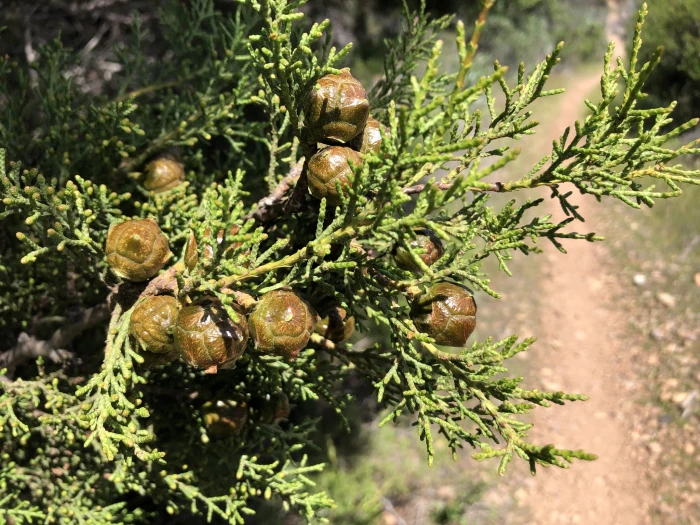Tecate Cypress
(Cupressus forbesii)
Tecate Cypress (Cupressus forbesii)
/
/

Kristen Francis
Public Domain
Image By:
Kristen Francis
Recorded By:
Copyright:
Public Domain
Copyright Notice:
Photo by: Kristen Francis | License Type: Public Domain | License URL: http://creativecommons.org/publicdomain/zero/1.0/ | Rights Holder: Kristen Francis | Publisher: iNaturalist | Date Created: 2020-04-04T20:00:14Z |



















































Estimated Native Range
Climate Requirements for Palm City, Florida
| This Plant | Your Site | Plant Suitability for Your Location | ||
|---|---|---|---|---|
| • Precipitation | 5" - 47" | 55" | Aquatic | Aquatic |
| • High Temp. | 75°F - 99°F | 91°F | Your summer temperatures are normal for this plant. | Excellent |
| • Low Temp. | 22°F - 50°F | 54°F | OK, but your winter temperatures are warmer than normal for this plant | OK |
This plant may not grow well at your location - your precipitation is too high.
Summary
Cupressus forbesii, commonly known as Tecate Cypress, is an evergreen tree native to the chaparral and coastal sage scrub of Southern California and Baja California in Mexico. It can grow up to 10 meters (33 feet) tall and is characterized by its dense, conical form and dark green foliage. The tree produces small, spherical cones that can be quite numerous. Tecate Cypress is particularly noted for its adaptability to the coastal climate of California, where it thrives in the cool temperatures and humidity, contrasting with other cypress species like Cupressus macnabiana, which are less tolerant of these conditions. A mature specimen at the San Francisco Botanical Garden demonstrates the species’ potential for longevity and reproductive success, even outside its native range.
Tecate Cypress is valued for its drought tolerance and ability to thrive in a variety of soil types, though it prefers well-drained soils. It is an excellent choice for urban planting, as it is relatively low-maintenance and can serve as a windbreak or privacy screen. While it does best in full sun, Tecate Cypress can also tolerate partial shade. Gardeners should be aware that this species can be susceptible to cypress canker, a disease that causes branch dieback and can be fatal. It is also important to consider that Tecate Cypress can become invasive when planted outside its native range, so care should be taken to monitor its spread.CC BY-SA 4.0
Tecate Cypress is valued for its drought tolerance and ability to thrive in a variety of soil types, though it prefers well-drained soils. It is an excellent choice for urban planting, as it is relatively low-maintenance and can serve as a windbreak or privacy screen. While it does best in full sun, Tecate Cypress can also tolerate partial shade. Gardeners should be aware that this species can be susceptible to cypress canker, a disease that causes branch dieback and can be fatal. It is also important to consider that Tecate Cypress can become invasive when planted outside its native range, so care should be taken to monitor its spread.CC BY-SA 4.0
Plant Description
- Plant Type: Tree
- Height: 15-30 feet
- Width: 15-20 feet
- Growth Rate: Moderate
- Flower Color: N/A
- Flowering Season: Non-Flowering
- Leaf Retention: Evergreen
Growth Requirements
- Sun: Full Sun
- Water: Low
- Drainage: Medium
Common Uses
Bird Garden, Deer Resistant, Drought Tolerant, Fragrant, Hedges, Low Maintenance
Natural Habitat
Native to the chaparral and coastal sage scrub of Southern California and Baja California
Other Names
Common Names: Forbes’ Cypress
Scientific Names: Hesperocyparis forbesii, Cupressus forbesii, Cupressus guadalupensis var. forbesii, Cupressus guadalupensis subsp. forbesii, Callitropsis forbesii, Neocupressus guadalupensis, Neocupressus guadalupensis var. forbesii
GBIF Accepted Name: Cupressus guadalupensis var. forbesii (Jeps.) Little